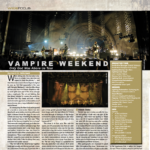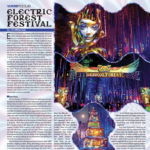Ricardo Ortiz Lights Elaborate Shows for Grammy-Winning Artist
Pepe Aguilar, the son of music and film stars Antonio Aguilar and Flor Silvestre, is an American-born singer who has made his mark in the Ranchera, Mariachi and pop genres of music.
Born into the world of live entertainment — he first performed on stage at age three — Aguilar has since won four Grammy Awards for Best Mexican American Album and Best Regional Mexican Music Album (Tejano). The singer, who spends a good portion of the year touring between Mexico and the U.S., has also been lauded with four Latin Grammy awards for Best Ranchero Album. We caught up with designer Ricardo Ortiz, who has been looking after Aguilar’s lighting for the last year.

Ricardo hails from Mexico City and has been in the lighting business for about 15 years now. “I have always been attracted to work on any stage,” he says. “I had the opportunity when I was younger to start working with a small company that owned some theatrical lighting. It didn’t take me long to realize that my passion lied in live concerts and the touring business.”

Ortiz has worked his way up, including lighting two different popular singers who reside in Mexico, Noel Schajris and Cristian Castro. He updated his skills by light-ing festivals in Mexico such as Cumbre Tajín and Festival Internacional Afrocaribeño. “Nowadays I am working with Ricardo Montaner, Franco De Vita and David Bisbal as well,” he states.

Aguilar’s tour makes stops at many different venues. This causes Ricardo and his partner, video director Hector Ortega, to change the look of their production, de-pending on each gig. We caught up with them at a packed show at the LA Forum on a Saturday night. “Tonight is a big show. We have the full lighting rig and all of our video components in play,” Ricardo says.

The lighting includes seven raked sticks of truss that expand outwards from upstage center to form a large fanned look. Five of these sticks have large white claws on the end of them, giving the light rig the look of a large cat’s paw. Ortiz explains, “We used five nails that extrude from the tips of the truss as an effect for the last part of the show, which is where Pepe sings the Banda Sinaloense music portion (Mexican Big Brass Band). It was an effect that we had planned from some shows back, and for this show at the Forum, we wanted to add some special touches.”

Elaborate Productions
There is also a front truss to provide key stage lighting as well as audience moles. An upstage truss and a floor package add more lighting to the production.

“Our show is often two-and-a-half hours long every night, and we have 21 band members on stage. That’s a lot of musicians. I have been using a lot of lighting fix-tures made by PR for this particular tour. I chose the lights specifically because I needed speed of response, constant functionality and brightness. The LED lights such as the PR Wash 3019 and the PR Wash 2007 give me a basic color to wash the whole stage. For the thin beams of light, I make use of the PR XR300 Beam fixture. It has 14 colors on a wheel and moves quickly.”

Providing the big gobo looks and hard edged beams was the PR XR1000 spot models he used for this show. “I love the gobos that come with the XR 1000. We get our lighting and video gear from First Born Productions, a company located down in Los Fresnos, Texas (near Brownsville). Account rep Mike Liendo does a great job provid-ing us the gear we need, and it has all been working quite well everywhere we go.”

The tour rig also includes a dozen Mega-Lite XS LED strobes. Mega Systems, a company out of Helotes, Texas (near San Antonio) distributes the PR brand as well as their own Mega Lite fixtures. Also emanating from the deck upstage center are a pair of 30-watt full color lasers, from Nu-Salt Laser International.

The video setup for this big show at the Forum includes a large landscape LED wall upstage center. There is a trolley system hanging from a truss that enables the designers to separate the video from one large wall into four square panels. There are also various video surfaces on the stage deck. The drummer lives center stage, perched above a six-foot square video panel. Two tiers of risers hold the rows of musicians when they are not downstage. The fronts of these risers are lined with LED tiles. Lastly, there are freestanding screens in a portrait configuration on both sides of the band risers.

“I use a full size grandMA to run the lighting and I will not change to any other console,” the LD declares. “It has a huge platform, tools, effects and macros. It’s the best console I have ever worked with.” He adds that he is currently working on programming all the video cues into MA Lighting VPUs (video processing units) so he can synchronize the lighting and video cues from one desk. “Hector cuts the camera shots and runs the video himself now.”

Ricardo is quick to credit others for help in the design of this show. “We work together as a team. Producer Gabriel Jauregui, the stage techs and I create a light plot and stage set that is functional for the tour. We need to be practical to give the best visual looks. With designs dictated by time of load in, distance between venues and, of course, the venue itself, we strive to accomplish all the requirements the artist has specified. But more importantly, the audience is paying for a ticket, and we want to satisfy them with the best show we can create for them.”
Pepe Aguilar returns to the live stage in California the first week of January, continuing his tour through 2017.



